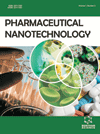- Home
- A-Z Publications
- Pharmaceutical Nanotechnology
- Previous Issues
- Volume 5, Issue 1, 2017
Pharmaceutical Nanotechnology - Volume 5, Issue 1, 2017
Volume 5, Issue 1, 2017
-
-
Pharmacokinetic Consequences of PLGA Nanoparticles in Docetaxel Drug Delivery
More LessAuthors: Pedram Rafiei and Azita HaddadiBackground: Cancer chemotherapy is accompanied with administration of highly potent cytotoxic agents in doses that can result in non-specific drug toxicity and side effects. Chemotherapeutic agents possess limitations such as lack of water solubility, high volume of distribution, poor bioavailability, narrow therapeutic indices, multi-drug resistance, etc. that raise serious matters of concern regarding drug’s pharmaceu Read More
-
-
-
Influencing Factors of the Pharmacokinetic Characters on Nanopharmaceutics
More LessAuthors: Xiwei Ji, Wei Lu, Kehua Wu and William C. ChoBackground: Nano-pharmaceutics have been actively studied for the encapsulation and targeted delivery of drugs to improve the treatment strategies for various diseases. Because of the size, nano-pharmaceutics show some special characteristics of pharmacokinetics (PK). There are quite a number of studies focusing on the efficacy and toxicity of nano-pharmaceutics. However, only few of them investigated PK. Meth Read More
-
-
-
Transdermal Lipid Nanocarriers: A Potential Delivery System for Lornoxicam
More LessAuthors: Sandipan Dasgupta, Subhabrata Ray, Sanjay Dey, Paulami Pal and Bhaskar MazumderBackground: Lornoxicam, is a NSAID of the oxicam class. Its short duration of action owing to rapid elimination and gastrointestinal side effects limits its usefulness when administered orally. Objective: The primary objective of the proposed work is to develop suitable lipid nanocarriers for transdermal delivery of Lornoxicam with increased drug residence time at local site of inflamation and in systemic circulation, overcomi Read More
-
-
-
pH-Sensitive Polymeric Nanoparticles Fabricated by Dispersion Polymerization for the Delivery of Bioactive Agents
More LessAuthors: Reema Puri, Solomon A. Berhe and Emmanuel O. AkalaBackground: Development of pH-responsive nanoparticles capable of rapid degradation in the acidic environments in the endosomes and lysosomes of tumor tissues but relatively more stable in the physiological pH (pH 7.4) is desirable. Objective: To show that the number of methoxy groups on the benzene ring of benzaldehyde bisacrylate acetal crosslinkers should affect the rate of hydrolysis of the crosslinkers and in Read More
-
-
-
Synthesis of Cross-linked Poly (N-isopropylacrylamide) Magnetic Nano Composite for Application in the Controlled Release of Doxorubicin
More LessAuthors: Sharif Kaamyabi, Abed Badrian and Abolfazl AkbarzadehBackground: Application of magnetic nanoparticles as a drug delivery system has attracted great attention in the cancer therapy, interests in the pH and thermo-sensitive polymers have been increased exponentially in biomedicine. Objective: (N-isopropylacrylamide)-ethylene glycol dimethacrylate copolymer was coated on the surface of Fe3O4 magnetic nanoparticles and utilized as a pH and temperature responsive Read More
-
Most Read This Month
Article
content/journals/pnt
Journal
10
5
false
en


